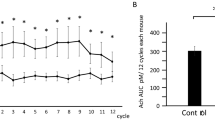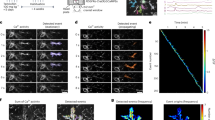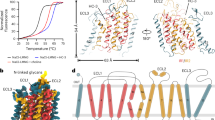Abstract
LITTLE is known about the factors which regulate the growth and development of the mammalian brain. Although proliferation of neuronal cells ceases relatively early in development, certain types of glial cells proliferate and differentiate mainly perinatally1. In the perinatal period, the ability of acetylcholine to stimulate phosphoinositide (PI) hydrolysis in brain reaches peak levels2, and indeed the stable acetylcholine analogue carbachol can stimulate PI hydrolysis of primary neonatal astroglial cells3. As PI hydrolysis is thought to be important in the regulation of cell proliferation4-6, we investigated whether cellular DNA synthesis can be induced by carbachol. Our results show that carbachol stimulates DNA synthesis via muscarinic acetylcholine receptors (mAChRs), in primary astrocytes derived from perinatal rat brain, in an age-dependent fashion. Carbachol is also mitogenic in certain brain-derived astrocytoma and neuroblastoma cell lines, as well as in Chinese hamster ovary (CHO) cells expressing recombinant muscarinic receptors. DNA synthesis is strongly activated by car-bachol in those brain-derived cell lines and transfected CHO cells that express mAChR subtypes which activate PI hydrolysis efficiently, and poorly activated in cells expressing mAChR sub-types which only weakly activate PI hydrolysis. These results strongly support a role for acetylcholine in regulating astroglial cell growth in the developing brain, and indicate that the specificity of acetylcholine-induced cell proliferation may be determined by the expression of those mAChR subtypes which activate PI hydro-lysis.
This is a preview of subscription content, access via your institution
Access options
Subscribe to this journal
Receive 51 print issues and online access
$199.00 per year
only $3.90 per issue
Buy this article
- Purchase on Springer Link
- Instant access to full article PDF
Prices may be subject to local taxes which are calculated during checkout
Similar content being viewed by others
References
Raff, M. C. Science 243, 1450–1455 (1989).
Balduini, W., Murphy, S. D. & Costa, L. G. J. Pharmac. exp. Ther. 241, 421–427 (1987).
Pierce, B. et al. J. Neurochem. 45, 1534–1539 (1985).
Rozengurt, E. Science 234, 161–166 (1986).
Berridge, M. J. A. Rev. Biochem. 56, 159–193 (1987).
Nishizuka, Y. Nature 334, 661–665 (1988).
Bottenstein, J. E. & Sato, G. H. Proc. natn. Acad. Sci. U.S.A. 76, 514–517 (1979).
Bingami, A., Eng, L. F., Dahl, D. & Uyeda, C. T. Brain Res. 43, 429–435 (1972).
Ashkenazi, A., Peralta, E. G., Winslow, J. W., Ramachandran, J. & Capon, D. J. Cold Spring Harb. Symp. quant. Biol. LIII, 263–272 (1988).
Kubo, T. et al. Nature 323, 411–416 (1986).
Kubo, T. et al. FEBS Lett. 209, 367–372 (1986).
Peralta, E. G. et al. Science 236, 600–605 (1987).
Peralta, E. G. et al. EMBO J. 6, 3923–3929 (1987).
Bonner, T. I., Buckley, N. J., Young, A. C. & Brann, M. R. Science 237, 527–532 (1987).
Bonner, T. I., Young, A. C., Brann, M. R. & Buckley, N. J. Neuron 1, 403–410 (1988).
Fukuda, K. et al. Nature 321, 623–625 (1987).
Ashkenazi, A. et al. Science 238, 672–675 (1987).
Peralta, E. G., Ashkenazi, A., Winslow, J. W., Ramachandran, J. & Capon, D. J. Nature 334, 434–438 (1988).
Fukuda, K. et al. Nature 335, 355–358 (1988).
Stein, R., Pinkas-Karamaski, R. & Sokolovsky, M. EMBO J. 7, 3031–3035 (1988).
Neher, E., Marty, A., Fukuda, K., Kubo, T. & Numa, S. FEBS Lett. 240, 88–94 (1988).
Bujo, H. et al. FEBS Lett. 240, 95–100 (1988).
Conklin, B. R. et al. Proc. natn. Acad. Sci. U.S.A. 85, 8698–8702 (1988).
Ashkenazi, A., Peralta, E. G., Winslow, J. W., Ramachandran, J. & Capon, D. J. Cell 56, 487–493 (1989).
Maeda, A., Kubo, T., Mishina, M. & Numa, S. FEBS Lett. 239, 339–342 (1988).
Fisher, S. K., Klinger, P. D. & Agranoff, B. W. J. biol. Chem. 258, 7358–7363 (1983).
Brown, J. H. & Brawn, S. L. J. biol. Chem. 259, 3777–3781 (1984).
Williams, B. P., Abney, E. R. & Raff, M.C. Devl. Biol. 112, 126–134 (1985).
Seuwem, K., Magnaldo, I. & Pouyssegur, J. Nature 335, 254–256 (1988).
Vincentini, L. M. & Villereal, M. L. Biochem. biophys. Res. Commun. 123, 377–384 (1984).
Jackson, T. R., Blair, L. A. C., Marshall, J., Goedert, M. & Hanley, M. R. Nature 335, 437–440 (1988).
Kimelberg, H. K. & Norenberg, M. D. Scient. Am. 260, 66–76 (1989).
Coyle, J. T. & Yamamura, H. I. Brain. Res. 118, 429–440 (1976).
Masters, S. B., Harden, T. K. & Brown, J. J. Molec. Pharmac. 26, 149–155 (1984).
Lichtshtein, D., Boone, G. & Blume, A. J. Cyc. Nucleotide Res. 5, 367–375 (1979).
Berridge, M. J., Downes, C. P. & Hanley, M. R. Biochem. J. 206, 587–595 (1982).
Author information
Authors and Affiliations
Rights and permissions
About this article
Cite this article
Ashkenazi, A., Ramachandran, J. & Capon, D. Acetylcholine analogue stimulates DNA synthesis in brain-derived cells via specific muscarinic receptor subtypes. Nature 340, 146–150 (1989). https://doi.org/10.1038/340146a0
Received:
Accepted:
Issue Date:
DOI: https://doi.org/10.1038/340146a0
This article is cited by
-
EGFR and PKC are involved in the activation of ERK1/2 and p90 RSK and the subsequent proliferation of SNU-407 colon cancer cells by muscarinic acetylcholine receptors
Molecular and Cellular Biochemistry (2012)
-
Oxotremorine treatment restores hippocampal neurogenesis and ameliorates depression-like behaviour in chronically stressed rats
Psychopharmacology (2011)
-
Growth-promoting effect of muscarinic acetylcholine receptors in colon cancer cells
Journal of Cancer Research and Clinical Oncology (2003)
-
Effects of ethanol on calcium homeostasis in the nervous system
Molecular Neurobiology (1999)
-
Specific Gq protein involvement in muscarinic M3 receptor‐induced phosphatidylinositol hydrolysis and Ca2+ release in mouse duodenal myocytes
British Journal of Pharmacology (1997)
Comments
By submitting a comment you agree to abide by our Terms and Community Guidelines. If you find something abusive or that does not comply with our terms or guidelines please flag it as inappropriate.



